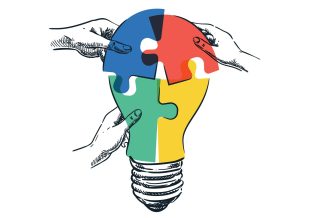TOOLS
Empathy interviews
By Kari Nelsestuen and Julie Smith
Categories: Collaboration, Facilitation, Implementation, Learning designs, PersonalizationOctober 2020
Vol. 41, No. 5
There has never been a more important time to practice empathy, as we face the formidable task of teaching and caring for students and their families during the dual pandemics of COVID-19 and systemic racism.
Empathy means trying to understand deeply the experiences and feelings of other people. It is both a mindset to embrace and a skill to practice. While we can never fully understand the experiences of another person, we can listen deeply to their stories and perspectives to uncover unacknowledged needs. As we listen, we must simultaneously examine how our own identities, biases, values, and experiences influence how we make meaning of what others share with us.
While many of us may already practice empathy in our daily lives, we’ve learned that one practice — empathy interviews — can help create more human-centered improvement practices across school systems.
Empathy interviews usually are one-on-one conversations that use open-ended questions to elicit stories about specific experiences that help uncover unacknowledged needs. A protocol allows the interviewer to probe more deeply into stories than a more traditional interview.
Empathy interviews help ensure that the diverse lived experiences of people are centered in decisions and actions. Although there is well-founded attention to data and research-based strategies in education, it is critical to include lived experience to more accurately and directly represent the lives of students and families who are often marginalized and excluded from traditional data and research methods.
For this reason, empathy interviews should be conducted with humility and awareness of the potential power dynamics at play, such as when teachers try to understand the lived experiences of chronically absent students and their families.
Examples of empathy interviews include:
- In virtual design camps, high school teachers conducted empathy interviews with students to more deeply understand their experiences with virtual learning. Teachers and students used the interview themes to co-design prototypes to improve the virtual experience.
- Educators from across a district conducted empathy interviews with students and families about attendance. They used the information to identify the root causes of chronic absenteeism from the community’s perspective.
- A regional network focused on supporting Black, Indigenous, and people of color educators used data from empathy interviews to design system changes to increase retention rates.
Empathy interviews can help identify issues that need to be addressed by the system, unpack the root causes of a problem from a community perspective, and gather information that inspires new, human-centered change ideas. Some people report that their interview practice is an intervention in and of itself since it provides a new structure for voices to be heard.
Click on each tool below to see “How to conduct empathy interviews.”
Categories: Collaboration, Facilitation, Implementation, Learning designs, Personalization
Recent Issues
BUILDING BRIDGES
December 2024
Students benefit when educators bridge the continuum of professional...
CURRICULUM-BASED PROFESSIONAL LEARNING
October 2024
High-quality curriculum requires skilled educators to put it into...
LEARNING TO PIVOT
August 2024
Sometimes new information and situations call for major change. This issue...
GLOBAL PERSPECTIVES
June 2024
What does professional learning look like around the world? This issue...












